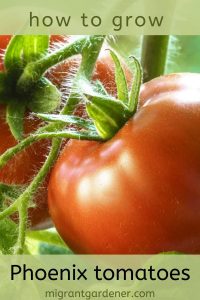Phoenix Tomato Plant Growing Notes:
-
- Phoenix tomato plants are determinate in growth habit.
-
- Phoenix tomato plants are resistant to gray leaf spot, Verticillium and Fusarium wilts, and Alternaria stem canker.
-
- The Phoenix tomato is available as an heirloom, cherry, and Roma grape.
How to Grow Phoenix Tomato
Phoenix tomato plants, and indeed, Phoenix tomatoes do particularly well in areas where the summertime temperatures sore. The plant was developed for Arizona-type growing conditions and it sets fruit (the fruits are nicely tasty) when the heat is at its most intense.
The fruits ripen in heavy loads simultaneously. Fruits are medium-sized, around 10-12 oz. (280-340 g), and red in color. They typically are ready to harvest over a very short period – 7 to 10 days. Fruits are ready for harvesting at around 70-75 days.
If the fruit-ripening timespan turns wet and rainy, Phoenix tomatoes are resistant to cracking.
In warmer zones, Phoenix tomatoes also do well in terms of a fall crop.
Phoenix tomato plants are resistant to gray leaf spot, to Verticillium and Fusarium wilts, and to Alternaria stem canker.
Plant spacing for Phoenix tomatoes: 18-36 inches apart depending on which type of ‘Phoenix’ you have (heirloom, grape, cherry, etc.). When you purchase your Phoenix tomato plants be sure to check the label/ stick that comes with them for correct plant spacing.
The plants, depending on the variety – heirloom, grape, cherry, etc., grow no taller than around 2-3 feet.
Plant your Phoenix tomato plants deeply so that two-thirds of the stem is in the soil. This encourages a more rampant route system to develop.
How about soil requirements for Phoenix tomato plants?
Same soil conditions as for most tomato plants. Phoenix wants nutrient-rich, well-drained soil for best results. You can, and should, amend your soil with garden compost or with some other organic matter before you plant. Your soil wants to be on the acidic to neutral side at around 6.4 to 7.0 in terms of pH.
Ensure that the soil is consistently moist throughout the entirety of the growing season. All tomato plants require consistent moisture in order to prevent the fruits from cracking and to avoid blossom end rot. As a way of avoiding water evaporation from the soil, add mulch around the base of your tomato plants.
As for pests, Phoenix tomato plants are susceptible to tomato hornworms, to slugs, and to pill bugs.
Read: 7 Beneficial Insects for Tomato Plants
With humid weather, the tomato plants can become susceptible to fungal disease – early and late blight, for example.
If the ambient air temperature drops below 55 degrees F or rises above 90 F the plants may be inclined to stop setting fruit.
If not provided with enough water blossom end rot can become an issue. A lack of water can also cause misshapen fruit.
For harvesting, a perfectly ripe Phoenix tomato will demonstrate its ripeness by way of its deep red coloring. It will still feel firm in your hand when you squeeze it gently. Again, though, for your specific variety, check the label/ stick for details.
Once the tomatoes have been harvested, store indoors and at room temperature. Either that or store them outside in a shaded area.
Don’t be tempted to put your tomatoes in the fridge. Tomatoes that are stored at temperatures of 55 degrees F or below suffer from a breakdown of compounds that negatively impact flavoring.
If you allow the tomatoes to remain on the vine after being harvested they will remain fresh for longer. Having said that, to enjoy flavor and nutritional value at its peak, consume your Phoenix tomatoes within 7 days of harvesting.
The amount of time your tomatoes can be stored will, of course, depend on the ripeness of the fruit when it is harvested so this 7-day consumption concept is dependent on the tomatoes ripeness when harvested.

One thought on “Phoenix Tomato – How to Grow”